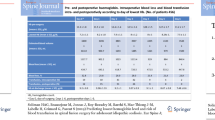Anemia is defined as a reduction of hemoglobin (Hb) levels of <13 g/dL for a man and <12 g/dL for a woman. It is very frequent among hospitalized patients and can be a serious problem in patients who undergo cervical spine surgery. Anemia can be classified as:
-
Mild (Hb: >10 g/dL)
-
Moderate (Hb: 8–10 g/dL)
-
Severe (Hb: 6–8 g/dL)
-
Very severe (Hb: <6 g/dL)
To identify the causes of anemia, we can use functional and morphologic criteria. However, from a practical point of view, the morphologic criteria are preferred and require the reticulocytes absolute number and the mean corpuscular volume (MCV), respectively. The flowchart for identifying the causes of anemia using morphologic criteria is reported in Fig. 2.1.
Access this chapter
Tax calculation will be finalised at checkout
Purchases are for personal use only
Similar content being viewed by others
References
Marks PW, Glader B (2005) Approach to anemia in the adult and child. In: Hoffman R, Benz AI jr, Shattil SJ, Furie B, Cohen HJ, Silberstein LE, McGlave P (eds) Hematology, basic principles and practice, 4th edn. Elsevier, Churchill Livingstone, Amsterdam, New York
Weiss G, Goodnough LT (2005) Anemia of chronic disease. N Engl J Med 352:1011–1023
Bergqvist D (2007) Risk of venous thromboembolism in patients undergoing cancer surgery and options for thrombo-prophylaxis. J Surg Oncol 95:167–174
Ruggeri M, Rodeghiero F, Tosetto A et al; Gruppo Italiano Malattie Ematologiche dell'Adulto (GIMEMA) Chronic Myeloproliferative Diseases Working Party (2008) Postsurgery outcomes in patients with polycythemia vera and essential thrombocythemia: a retrospective survey. Blood 111:666–671
Palmblad JE, Von dem Borne AE (2002) Idiopathic, immune, infectious and idiosyncratic neutropenias. Semin Hematol 39:113–120
Kipps TJ (1995) Lymphocytosis and Lymphocytopenia. In. Beutler E, Lichtman MA, Coller BS, Kipps DJ (eds) Williams hematology. Mc Graw Hill, New York
Buckley MF, James JW, Brown DE et al (2000) A novel approach to the assessment of variations in the human platelet count. Thromb Haemost 83:480–484
Schafer AI (2004) Thrombocytosis. N Engl J Med 350:1211–1219
Messinezy M, Westwood N, Sawyer B et al (1994) Primary thrombocythaemia: a composite approach to diagnosis. Clin Lab Haematol 16:139–148
Vannucchi AM, BarbuiT (2007) Thrombocytosis and thrombosis. Hematology Am Soc Hematol Educ Program 363–370
George JN, Woolf SH, Raskob GE et al (1996) Idiopathic thrombocytopenic purpura: a practice guideline developed by explicit methods for the American Society of Hematology. Blood 88:3–40
http://www.siset.org/lineeguida/LG4.pdf (Last revision 4 June 2007)
International Myeloma Working Group (2003) The International Myeloma Working Group criteria for the clas-sification of monoclonal gammopathies, multiple myeloma and related disorders: a report of the International Myeloma Working Group. Br J Haematol 121:749–757
Lord RS (1973) Vertebrobasilar ischaemia and the extracra-nial arteries. Med J Aust 7:32–37
Hayward CPM, Rao AK, Cattaneo M (2006) Congenital platelet disorders: overview of their mechanisms, diagnostic evaluation and treatment. Haemophilia 12:128–136
Shen Y-M, Frenkel E (2007) Acquired platelet dysfunction. Hematol Oncol Clin N Am 21:647–661
Patrono C (1994) Aspirin as an antiplatelet drug. N Engl J Med 330:1287–1293
Hirsh J, Dalen JE, Fuster V et al (1995) Aspirin and other platelet-active drugs. The relationship among dose, effectiveness, and side effects. Chest 108:247–257
Antman EM, Benett JS, Daugherty A et al (2007) Use of nonsteroidal antiinflammatory drugs: an update for clinicians: a scientific statement from the American Heart Association. Circulation 115:1634–1642
Jacobson AK (2004) Platelet ADP receptor antagonists: ticlopidine and clopidogrel. Best Pract Res Clin Haematol 17:55–64
Reding MT (2005) Hematologic problems in the surgical patient: bleeding and thrombosis. In: Hoffman R, Benz AI jr, Shattil SJ, Furie B, Cohen HJ, Silberstein LE, McGlave P (eds) Hematology, basic principles and practice, 4th edn. Elsevier, Churchill Livingstone, Amsterdam, New York
Kitchen S, Makris M (2005) Laboratory tests of hemostasis. In: O'Shaughnessy D, Makris M, Lillicrap D (eds) Practical hemostasis and thrombosis. Blackwell, USA
Ageno W, Squizzato A, Garcia D et al (2006) Epidemiology and risk factors of venous thromboembolism. Semin Thromb Hemost 32:651–658
Mazzolai L, Duchosal MA (2007) Hereditary thrombophilia and venous thromboembolism: critical evaluation of the clinical implications of screening. Eur J Vasc Endovasc Surg 34:483–488
Simioni P, Tormene D, Spiezia L (2006) Inherited thrombo-philia and venous thromboembolism. Semin Thromb Hemost 32:700–708
Epstein NE (2005) A review of the risk and benefits of differing prophylaxis regimens for the treatment of deep venous thrombosis and pulmonary embolism in neurosurgery. Surg Neurol 64:295–302
Brambilla S, Ruosi C, La Maida GA et al (2004) Prevention of venous thromboembolism in spinal surgery. Eur Spine J Feb; 13(1):1–8
Geerts WH, Bergqvist D, Pineo GF, Heit JA et al (2008) Prevention of venous thromboembolism: American college of chest physicians evidence-based clinical practice guidelines (8th edn). Chest 133:381S–453S
Author information
Authors and Affiliations
Corresponding author
Editor information
Editors and Affiliations
Rights and permissions
Copyright information
© 2010 Springer-Verlag Berlin Heidelberg
About this chapter
Cite this chapter
Avvisati, G. et al. (2010). Hematologic Issues in Cervical Spine Surgery. In: Denaro, L., D'Avella, D., Denaro, V. (eds) Pitfalls in Cervical Spine Surgery. Springer, Berlin, Heidelberg. https://doi.org/10.1007/978-3-540-85019-9_2
Download citation
DOI: https://doi.org/10.1007/978-3-540-85019-9_2
Publisher Name: Springer, Berlin, Heidelberg
Print ISBN: 978-3-540-85018-2
Online ISBN: 978-3-540-85019-9
eBook Packages: MedicineMedicine (R0)



